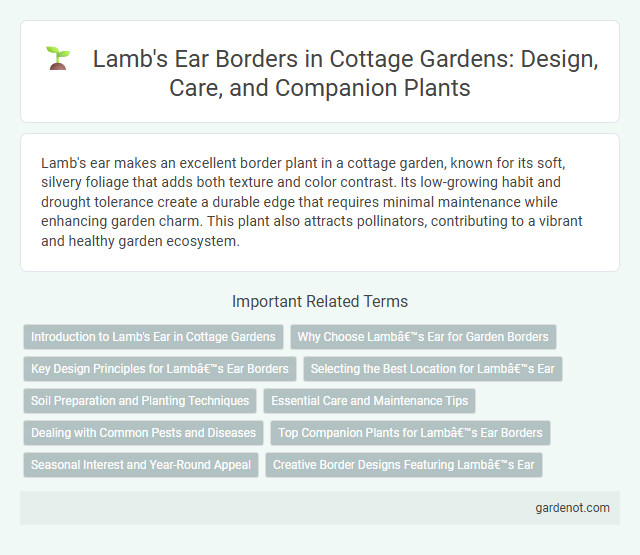Lamb's ear makes an excellent border plant in a cottage garden, known for its soft, silvery foliage that adds both texture and color contrast. Its low-growing habit and drought tolerance create a durable edge that requires minimal maintenance while enhancing garden charm. This plant also attracts pollinators, contributing to a vibrant and healthy garden ecosystem.
Introduction to Lamb's Ear in Cottage Gardens
Lamb's Ear (Stachys byzantina) is a popular choice for cottage gardens due to its soft, velvety silver-gray foliage that contrasts beautifully with colorful flowers. This low-maintenance perennial thrives in well-drained soil and full sun, creating a natural, textured border that enhances the informal charm of cottage garden beds. Its drought tolerance and deer resistance make Lamb's Ear an ideal ground cover and edging plant in traditional and modern cottage garden designs.
Why Choose Lamb’s Ear for Garden Borders
Lamb's Ear (Stachys byzantina) is ideal for garden borders due to its soft, silvery foliage that creates a striking contrast with vibrant blooms while adding texture. Its drought tolerance and low maintenance requirements make it perfect for sustainable cottage gardens. The plant's ability to thrive in various soil types and its natural resistance to pests contribute to a healthy, long-lasting border.
Key Design Principles for Lamb’s Ear Borders
Lamb's ear borders thrive when planted in well-drained soil under full sun to partial shade, creating a soft, silvery-green carpet ideal for contrasting with vibrant blooms. Maintain consistent spacing of 12-18 inches to allow their fuzzy foliage to form a dense, uniform border that defines garden pathways and beds. Regular trimming of flower spikes enhances the plant's lush appearance while preventing self-seeding and promoting a tidy, controlled cottage garden aesthetic.
Selecting the Best Location for Lamb’s Ear
Lamb's ear thrives in well-drained soil and full sun to partial shade, making it essential to choose a location that balances sunlight exposure with soil moisture. Ideal planting sites have good air circulation to prevent fungal diseases and protect the soft, woolly foliage. Positioning Lamb's ear along pathways or as a border plant enhances its silvery texture while ensuring it receives the optimal growing conditions for vibrant, healthy leaves.
Soil Preparation and Planting Techniques
For optimal growth of Lamb's ear (Stachys byzantina) borders in a cottage garden, prepare well-draining soil by loosening it to a depth of 12 inches and incorporating organic matter such as compost to improve texture and fertility. Plant Lamb's ear in full sun to partial shade, spacing each plant 12 to 18 inches apart to allow for spreading and airflow, which reduces risk of disease. Water the plants thoroughly after planting and mulch around the base to retain moisture while preventing soil-borne pathogens from affecting the fuzzy leaves.
Essential Care and Maintenance Tips
Lamb's ear (Stachys byzantina) thrives in well-drained soil with full sun to partial shade, requiring minimal watering once established to prevent root rot. Regularly remove spent flower stalks and trim back woolly leaves in late fall to promote healthy growth and maintain a tidy appearance. Mulching helps retain soil moisture and suppress weeds, supporting the plant's soft, silvery foliage to flourish as a charming border in cottage gardens.
Dealing with Common Pests and Diseases
Lamb's ear borders are prone to pests like aphids and spider mites, which can be controlled using insecticidal soaps or neem oil sprays. Powdery mildew is a common disease affecting Lamb's ear; improving air circulation by spacing plants properly and avoiding overhead watering helps minimize infection. Regular inspection and prompt removal of infected leaves maintain plant health and preserve the visual appeal of the cottage garden.
Top Companion Plants for Lamb’s Ear Borders
Lamb's ear borders thrive when paired with companion plants that complement their soft, silvery foliage and provide contrasting textures or vibrant colors. Top companion plants include purple coneflowers (Echinacea purpurea), which add height and bright blooms, and catmint (Nepeta), whose lavender flowers attract pollinators. Other excellent choices are coreopsis for sunny bursts of yellow and hardy geraniums that offer ground-level color, enhancing the visual appeal of Lamb's ear garden borders.
Seasonal Interest and Year-Round Appeal
Lamb's ear border provides soft, silvery foliage that maintains vibrant texture and color throughout the growing season, enhancing any cottage garden's seasonal interest. Its fuzzy leaves offer a tactile contrast to blooming perennials and grasses, creating visually appealing layers from spring through fall. Hardy and drought-resistant, Lamb's ear remains attractive year-round, often retaining structure and subtle hues even in winter, sustaining continuous garden appeal.
Creative Border Designs Featuring Lamb’s Ear
Lamb's ear (Stachys byzantina) creates a soft, silvery-green border that contrasts beautifully with vibrant flowering plants in cottage garden designs. Its velvety texture and drought-resistant nature make it ideal for defining garden edges while adding tactile interest and year-round appeal. Creative border designs often pair lamb's ear with pastel blooms like lavender, foxglove, or daisies to enhance a whimsical, nostalgic aesthetic.
Lamb's ear border Infographic

 gardenot.com
gardenot.com